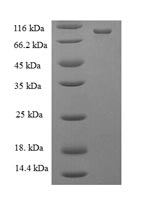Recombinant Escherichia coli DNA mismatch repair protein MutL comes from an E.coli expression system and includes an N-terminal 6xHis-tag that makes purification and detection more straightforward. The full-length protein covers amino acids 1 to 615 and reaches greater than 90% purity based on SDS-PAGE analysis. It's designed for research purposes and appears to meet strict quality standards that should support demanding scientific work.
MutL seems to be a critical piece of the DNA mismatch repair machinery in Escherichia coli. Its role in maintaining genetic stability is likely fundamental - the protein works by connecting with other repair components to fix errors that slip through during DNA replication. Research into DNA repair mechanisms and their effects on genomic integrity probably depends heavily on understanding how MutL operates.
Potential Applications
Note: The applications listed below are based on what we know about this protein's biological functions, published research, and experience from experts in the field. However, we haven't fully tested all of these applications ourselves yet. We'd recommend running some preliminary tests first to make sure they work for your specific research goals.
The E. coli MutL is a key DNA mismatch repair protein that requires correct folding, dimerization, and ATPase activity for its function. Since it is expressed in its native host (E. coli), there is a high probability of correct folding, as the cellular environment provides necessary chaperones and conditions. The small His tag is unlikely to significantly interfere with folding or dimerization. However, without experimental validation (e.g., ATPase activity assay or dimerization check), the protein cannot be assumed to be correctly folded or bioactive. The high purity indicates low impurities, but does not guarantee functionality.
1. Protein-Protein Interaction Studies with DNA Mismatch Repair Components
If the recombinant MutL is verified to be correctly folded and bioactive (e.g., through ATPase activity or dimerization assays), it can be used to study interactions with MutS and MutH using techniques like co-immunoprecipitation or SPR. However, if misfolded, interactions may be non-physiological. Validate any identified interactions with native MutL from E. coli extracts.
2. Antibody Development and Validation
This application is suitable. The full-length MutL can serve as an immunogen for generating antibodies against linear epitopes. The high purity supports consistent immunization. However, antibodies generated may not recognize conformational epitopes of native MutL if the protein is misfolded. Validate antibody specificity against native E. coli MutL in Western blot or immunofluorescence.
3. His-Tag Mediated Pull-Down Assays
The His-tag allows for pull-down assays to identify binding partners. However, if MutL is misfolded, it may not interact correctly with physiological partners, leading to false positives/negatives. Confirm protein folding and activity before use, and validate partners with native MutL.
4. Biochemical Characterization and Enzyme Kinetics Studies
Biochemical characterization (e.g., oligomerization via size-exclusion chromatography, stability via thermal shift assays) is feasible without activity validation. However, enzyme kinetics studies (e.g., ATPase activity) require confirmed bioactivity. First, validate ATP hydrolysis activity before kinetic experiments.
Final Recommendation & Action Plan
Before using this recombinant MutL for functional studies, prioritize experimental validation of its folding and bioactivity. Start with an ATPase activity assay to confirm functionality and a size-exclusion chromatography analysis to check dimerization. If active, proceed with interaction or kinetic studies; if inactive, limit use to non-functional applications like antibody production (with validation against native MutL). For reliable results, always include controls with native E. coli MutL in key experiments.






